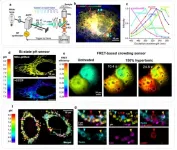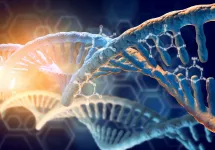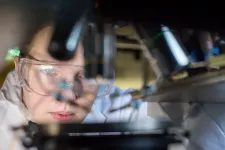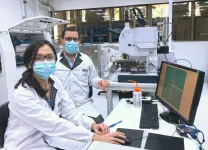A hairpin to fight cancer
Bicyclic protein mimetics inhibit the oncogene β-catenin
2021-05-12
(Press-News.org) The inhibition of pathological protein-protein interactions is a promising approach for treating a large number of diseases, including many forms of cancer. A team of researchers has now developed a bicyclic peptide that binds to beta-catenin--a protein associated with certain types of tumor. The secret of their success is the cyclic nature and the hairpin shape of the peptide, which mimics a natural protein structure, they report in the journal Angewandte Chemie.
Because of the extensive protein regions involved in protein-protein interactions, therapeutic approaches involving small molecules are often unsuccessful. Protein mimetics are alternatives that imitate the spatial structure of binding segments of natural protein binding partners. Although beta-sheets--protein structures made of several stretched out peptide chains arranged side by side, resembling a sheet of paper folded like an accordion--often play a role in the interaction of proteins, they have rarely been used as a basis for mimetics. This is partly because they have problems entering the target cell, and thus, cannot reach the pathogenic protein.
Led by Tom N. Grossmann, an international team from the Vrije Universiteit Amsterdam (Netherlands), Università degli Studi di Napoli "Federico II" (Italy), as well as AstraZeneca (Cambridge, UK), has now reported the design of β-sheet mimetics that inhibit the intracellular oncogenic protein beta-catenin. beta-Catenin is a component of the Wnt signaling pathway and activates T-cell factors (TCF), which ultimately stimulate cell growth and proliferation. Hyperactivation of the Wnt pathway is associated with various forms of cancer. Inhibition of the interaction between beta-catenin and TCF is thus an appealing therapeutic approach.
Based on the known structure of beta-catenin when it is in a complex with a protein, the team first produced a binding partner for beta-catenin. This partner is a ring-shaped peptide that forms a short, antiparallel beta-sheet--known as a beta-hairpin structure--when it is bound to beta-catenin, as demonstrated by an analysis of its crystal structure. The idea was to fix this cyclic peptide in the hairpin form by introducing an additional bridge. This generates a bicyclic structure that strengthens binding to beta-catenin. By using a series of different synthesized variants, the team was able to identify several bicyclic peptides with a high affinity for beta-catenin. Among these, they found a compound that (other than the original cyclic peptide) successfully penetrates cells and significantly inhibits the oncogenic Wnt signal cascade.
This newly developed bicyclic beta-sheet mimetic thus represents a possible starting point for the development of new antitumor drugs that inhibit cellular Wnt signaling. This strategy could also be used for the design of further inhibitors of other protein-protein interactions mediated by beta-sheets.
INFORMATION:
About the Author
Dr. Tom N. Grossmann is Professor of Organic and Biomimetic Chemistry at the Vrije Universiteit Amsterdam (The Netherlands). He heads a research group that, inspired by natural proteins, designs molecules with unique properties for applications in drug discovery and biocatalysis. His research is supported by the Dutch and the European Research Council.
https://www.grossmannlab.com/
ELSE PRESS RELEASES FROM THIS DATE:
2021-05-12
In a new study from Lund University and the University of Gothenburg, patients were interviewed about their experiences ten years after undergoing obesity surgery. The results show that the effect on eating and weight regulation persisted, whereas other problems, such as feelings of guilt about still not being healthy enough, remained.
"This is one of few follow-ups from a patients perspective so long after surgery", says My Engström, researcher in nursing at the University of Gothenburg.
18 patients were interviewed in the study. All of them experienced that their eating habits and appetite were still affected after the operation: their bodies still objected, preventing ...
2021-05-12
Mycobacterium tuberculosis is incredible in that it can survive for decades within its human host. It does this by varying its diet to successfully steal nutrients from the human host including immune cells; it is known to acquire and absorb multiple carbon sources from the body during infection.
In a paper published in the journal Molecular Systems Biology, Surrey scientists detail how they measure the flow of metabolites or "fluxes" through metabolic pathways when Mycobacterium tuberculosis is consuming some of its favourite nutrients. Measuring these 'fluxes' could help scientists advance new tuberculosis drugs as well as understand why the bacterium survives so long in humans and why current antibiotics are often ineffective.
By growing Mycobacterium ...
2021-05-12
The multiplexing capability of fluorescence microscopy is severely limited by the broad fluorescence spectral width. Spectral imaging offers potential solutions, yet typical approaches to disperse the local emission spectra notably impede the attainable throughput and place substantial constraints on temporal resolution. Tunable bandpass filters provide a possibility to scan through the emission wavelength in the wide field. However, applying narrow bandpasses to the fluorescence emission results in inefficient use of the scarce signal.
In a new paper published in Light: Science & Application, a team of scientists, led by Professor Ke Xu ...
2021-05-12
The DNA sequences produced are also called oligonucleotides. These are widely used for disease identification, for the manufacture of oligonucleotide-based drugs, and for several other medical and biotechnological applications.
The high demand for oligonucleotides therefore requires an efficient automated method for their chemical production.This process relies on phosphoramidites, which are chemical compounds that have the disadvantage of being unstable unless stored at the ideal -20 degrees Celsius.
Instruments used for DNA synthesis are not able to cool down the phosphoramidites, and consequently it is unavoidable that some of them degrade after being added ...
2021-05-12
"We're meant to be crossing over ... but the bridge is broken": 2020 university graduates' experiences of the pandemic in Ireland
A new study from Trinity College Dublin investigating the impact of the COVID pandemic on young adults finds that they are vastly more affected than older people, and the reverberations of the disruption to some will last decades. Researchers say this group have paid a high price in the form of foregone opportunities for education, social networks, and labour market integration.
The research, involving university graduates in Ireland, is published in YOUNG: ...
2021-05-12
A researcher at University of Limerick has developed a low-cost, environmentally friendly sensor that can detect damage in pipelines and could save water as a result.
The damage detection sensor uses highly sensitive, eco-friendly crystals that generate an electrical signal in response to a leak.
It is the first validation of these biological crystals for real world applications, according to Dr Sarah Guerin, a postdoctoral researcher at the Department of Physics and the Bernal Institute in UL, who has been developing amino acid crystal devices since 2017.
An Irish research collaboration between the Bernal Institute at UL and the Dynamical Systems and Risk Laboratory in University College Dublin has validated ...
2021-05-12
In mathematics, simple equations can generate a complex evolution in time and intriguing patterns in space. One famous example of this is the Mandelbrot set, named after the French-American mathematician of Polish origin, Benoit B. Mandelbrot (1924-2010), the most studied fractal. This set is based on a single quadratic equation with only one parameter and one variable. The fascinating fractal patterns of the Mandelbrot set have attracted attention far beyond mathematics.
An article by Ralph Andrzejak, entitled "Chimeras confined by fractal boundaries in the complex plane", forms part of a special edition of the journal Chaos in memory of Russian professor Vadim S. Anishchenko, (1943-2020), published on 3 May 2021. Andrzejak is head of the Nonlinear Time Series Analysis Group ...
2021-05-12
Intelligent materials, the latest revolution in the field of materials science, can adapt their properties depending on changes in their surroundings. They can be used in everything from self-healing mobile phone screens, to shape-shifting aeroplane wings, and targeted drug delivery. Delivering drugs to a specific target inside the body using intelligent materials is particularly important for diseases like cancer, as the smart material only releases the drug payload when it detects the presence of a cancer cell, leaving the healthy cells unharmed.
Now, researchers from the Centre ...
2021-05-12
Researchers at the Francis Crick Institute and the Latvian Institute of Organic Synthesis have designed a drug-like compound which effectively blocks a critical step in the malaria parasite life cycle and are working to develop this compound into a potential first of its kind malaria treatment.
While drugs and mosquito control have reduced levels of malaria over recent decades, the parasite still kills over 400,000 people every year, infecting many more. Worryingly, it has now developed resistance to many existing antimalarial drugs, meaning new treatments that work in different ways are urgently needed.
In their research, published in PNAS, the scientists developed a set of compounds designed to stop the parasite being able to burst out of red ...
2021-05-12
Multiple sclerosis, or MS for short, manifests itself slightly differently in each person - which is why some call it "the disease of a thousand faces." Arguably the worst manifestation of MS is its chronic progressive form. Unlike the more common relapsing-remitting variant (RRMS), in which sufferers are often symptom-free for months or even years, patients with the primary progressive form of the disease (PPMS) see their condition steadily deteriorate with no remissions.
Poorly insulated neurons die off
Today's therapeutic approaches are based on the assumption that the immune system is making a mistake and waging an inappropriate attack on the layer of myelin that surrounds and insulates the nerve cells' long, ...
LAST 30 PRESS RELEASES:
[Press-News.org] A hairpin to fight cancer
Bicyclic protein mimetics inhibit the oncogene β-catenin



